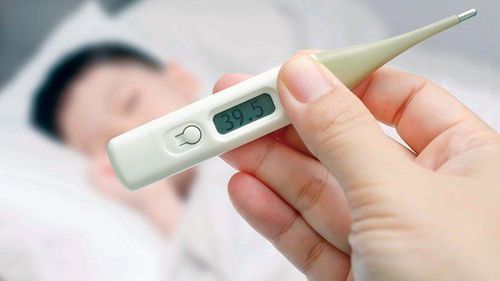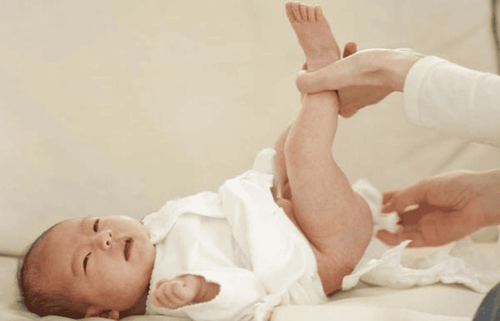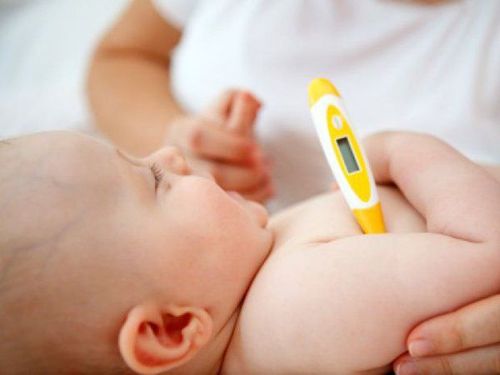This is an automatically translated article.
The article is professionally consulted by Resident Doctor, Master Dang Thi Ngoan - Department of Pediatrics - Neonatology - Vinmec Ha Long International Hospital.1. When to take your baby's temperature?
In some of the following cases, parents need to pay attention and conduct monitoring and measure the child's temperature if the child feels:Unwell and feels hotter than usual Irritability, crying a lot, refusing to eat, stop feeding... Drowsiness or sleeping more than usual Pain Inability to drink Vomiting
Trắc nghiệm: Sự phát triển tinh thần, vận động của bé thế nào là đúng chuẩn?
Khi nào bé biết nói, biết hóng chuyện hay biết cầm cốc là "đúng chuẩn"? Điểm xem bạn biết được bao nhiêu mốc phát triển tinh thần, vận động "đúng chuẩn" của bé nhé!The following content is prepared under supervision of Thạc sĩ, Bác sĩ y khoa, Ma Văn Thấm , Nhi , Phòng khám Đa khoa Quốc tế Vinmec Dương Đông(Phú Quốc)
2. Types of thermometers to measure temperature for children
Many parents often put their hand on their child's forehead to check if the child has a fever, but this is not really a reliable method. To know the exact body temperature of a child, the most effective way is to use a thermometer. Most modern thermometers are technical thermometers. Some of the most common types of thermometers commonly used for children will be mentioned shortly:2.1. Digital Multi-Purpose Thermometer The digital multi-function thermometer is the most basic and common type of thermometer.

Oral: The thermometer is placed under the child's tongue to take the temperature Armpit: The thermometer is clamped by the child. into the child's armpit. Digital multi-use thermometers often give the most accurate results when taking a child's oral temperature. If you want to check your baby's temperature with an oral or armpit digital multifunction thermometer, be sure to clean the thermometer after each use. The thermometer probe can be cleaned with warm soapy water or an alcohol wipe. Although a digital multi-use thermometer can be used to take rectal temperature, this is not recommended. The probe of the thermometer can damage the lining of the baby's rectum.
2.2. Digital Ear Thermometer The digital ear thermometer is specially designed for use with children's ears. The ear thermometer gives results very quickly and is easy to use, but in return, the accuracy of the temperature readings measured by the digital ear thermometer is not high.

Digital artery thermometers are the easiest to use, but their accuracy is not very high. Experts recommend that if other thermometers are not available, this thermometer should be used. One advantage of a digital arterial thermometer is that it can measure the child's body temperature without disturbing the child's sleep.
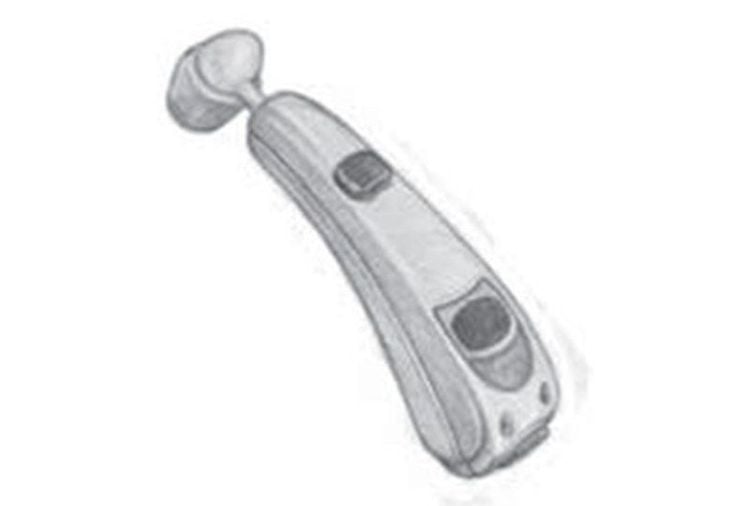
3. How to measure a child's temperature
Regardless of the type of thermometer used, first and foremost, read the instruction manual that came with the thermometer carefully the first time you use it. Here are some tips parents can apply to accurately measure their baby's body temperature.3.1. Oral Temperature Measurement Parents can use a digital multi-function thermometer to measure their baby's oral temperature. Steps to take an oral temperature include:
Give the child a glass of warm water to drink, wait 5 minutes, then take the measurement Put the thermometer under the side of the child's tongue Instruct the child to hold the thermometer with his lips instead of his teeth and store it. The child must breathe through the nose. Wait until the thermometer beeps, indicating that the measurement is complete, then take out the thermometer and read the temperature value displayed on the digital display. The temperature in the baby's oral cavity is usually about 0.5oC lower than the body temperature, so this value should be added to the value obtained from the thermometer to accurately estimate the baby's body temperature.
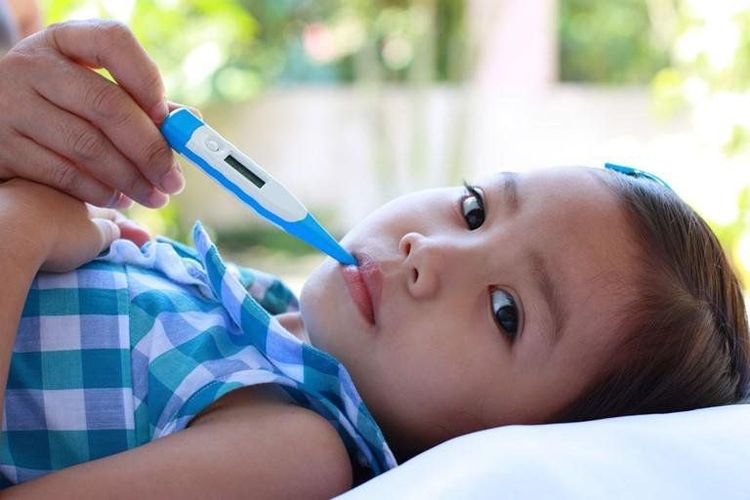
3.2. Taking axillary temperature Measuring a child's armpit temperature includes the following steps:
Put the thermometer in the child's armpit Ask the child to close his or her hand to keep the thermometer fixed in the armpit Wait until the thermometer beeps, signaling When the measurement is complete, take the thermometer out and check the temperature value displayed on the digital display. Add 10°C to the resulting temperature to get an accurate estimate of body temperature. Armpit temperature measurement is a relatively easy method to perform, especially for young children. However, this measurement is also less accurate than measuring the temperature in the oral cavity.
3.3. Ear temperature measurement The child's ear temperature is measured with a specific thermometer, specifically for measuring ear temperature. Steps to take baby's ear temperature include:
Place a plastic tip on the tip of the thermometer Gently insert the tip into the child's ear canal. Wait until the thermometer beeps, indicating that the measurement is complete, then remove the thermometer and read the temperature value displayed on the digital display. In the case of using the correct type of thermometer as well as the child's ear canal is not too small and there is not too much earwax, the ear thermometer has an error of about 10C. 3.4 Measuring forehead temperature The child's forehead temperature can be measured with a temporal artery thermometer.
Make sure the child's forehead is completely dry before starting the measurement. Then gently sweep the thermometer across your baby's forehead. Check the measurement results on the digital display and read the temperature readings.
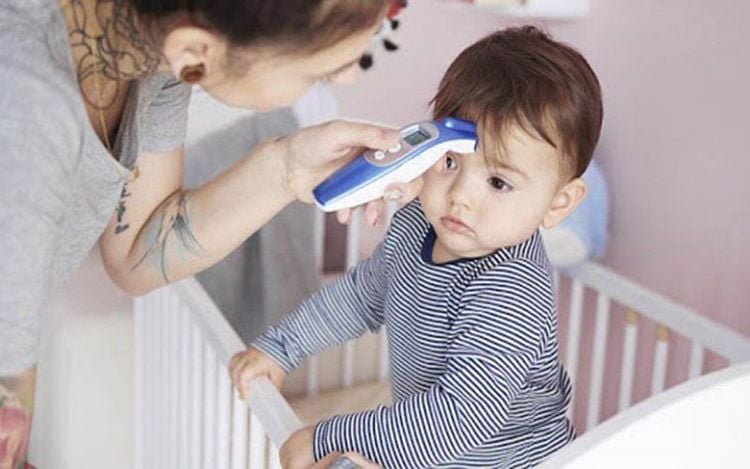
4. Children with high fever need to be taken to the doctor
Infants under three months with fever should be taken immediately to medical facilities for timely diagnosis and treatment. Doctors can determine if a child is at risk for serious medical conditions.Children between 3 and 12 months old, fever can be a sign of a serious illness, so it is also necessary to take them to medical facilities for examination and treatment.
For children over 12 months of age, take the child to a medical facility or call an ambulance immediately if the child has a high fever along with other serious signs such as severe pain, drowsiness, skin paleness, dehydration, difficulty breathing, stiff neck, continuous vomiting.... In the absence of the above signs but the child's body temperature does not show any signs of decreasing in 48 hours, it can also be considered as emergency condition.
The most effective way to check a child's body temperature is to use the digital thermometers that have been widely adopted over the years. The digital multi-use thermometer gives the most accurate results by measuring the temperature under the child's tongue or armpit. Ear thermometers and temporal artery thermometers are easy to use, but not very accurate. In addition, mercury thermometers and rectal temperature measurement methods are currently not recommended because they can be dangerous for children.
When taking the child's temperature, it is found that the child's body temperature is too high or the fever is accompanied by many unusual symptoms such as convulsions, rashes,... Parents should quickly take their children to the centers reputable medical center for timely examination and treatment.
For children to be healthy and develop well, it is necessary to have a nutritious diet in terms of quantity and quality balance. If children are not provided with adequate and balanced nutrients, it will lead to diseases of excess or lack of nutrients, which adversely affect the comprehensive development of children in terms of physical, mental and motor skills.
Children who do not eat properly are at risk of micro-mineral deficiency causing anorexia, growth retardation, malabsorption,... If they notice the above signs, parents should supplement their children with products. The supplement contains lysine, essential micro-minerals and vitamins such as zinc, chromium, selenium, and B vitamins to help fully meet the nutritional needs of children. At the same time, these essential vitamins also support digestion, enhance nutrient absorption, help improve anorexia, and help children eat well.
Parents can learn more:
Signs of zinc deficiency in children
Micronutrient deficiency and failure to gain weight in children
Please regularly visit Vinmec.com website and update useful information to take care of your child. Take care of the baby and the whole family.







